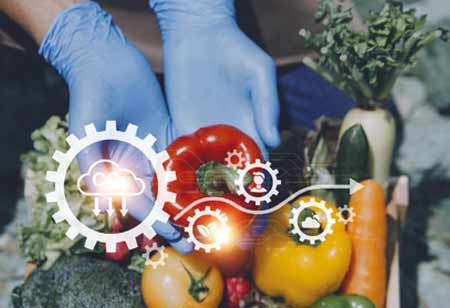Thank you for Subscribing to Food Business Review Weekly Brief
- Home
- Topics
- Alternative Proteins and Plant Based Food
- Beer and Wine
- Canned Beverages
- Coffee And Tea
- Food and Beverage Consulting
- Food and Beverage Financial Service
- Food And Beverages Marketing
- Food Distributors
- Food Ingredients
- Food Sustainability
- Plant Based Food and Beverages
- Seafood Suppliers
- Supplement Manufacturing
- Wine Investment
- News
- Vendor Viewpoint
- CXO Insights
- Conferences
- Newsletter
- CXO Awards
-
Optimizing the Food Supply Chain: The Overlooked Synergy Between 4PL Providers and Foodservice Equipment Efficiency
The convergence of 4PL logistics and equipment efficiency is not just beneficial—it is foundational to building a resilient, cost-effective, and sustainable Canadian food supply chain.

By
Food Business Review | Wednesday, June 18, 2025
Stay ahead of the industry with exclusive feature stories on the top companies, expert insights and the latest news delivered straight to your inbox. Subscribe today.

Fremont, CA: Canada's vast geography, diverse climate, and stringent food safety regulations present unique challenges for its food supply chain. In an era where consumers demand freshness, transparency, and sustainability, the efficiency of this intricate network is paramount. While advancements in logistics and technology are often highlighted, a critical yet frequently overlooked synergy exists between Fourth-Party Logistics (4PL) providers and the optimization of foodservice equipment efficiency. This collaboration holds the promise of significant benefits, offering a hopeful outlook for the future of Canada's food supply chain.
Foodservice Equipment Efficiency: A Silent Contributor to Supply Chain Optimization
Often regarded merely as operational assets within individual foodservice establishments, commercial kitchen equipment plays a far more influential role in the broader food supply chain than is commonly acknowledged. Its efficiency directly affects multiple facets of supply chain performance, with far-reaching implications for sustainability, cost management, and overall operational resilience.
One of the most significant areas of impact is energy consumption. Commercial kitchens are notably energy-intensive, with food preparation activities consuming substantial amounts of electricity. Energy-efficient equipment—such as ENERGY STAR-certified fryers, ovens, and refrigerators—not only lowers utility costs for operators but also supports broader sustainability initiatives. This shift toward greener technologies aligns with increasing consumer expectations for environmentally responsible practices across the food industry.
Advanced kitchen equipment can contribute to significant reductions in food waste. Innovations in refrigeration, precise temperature control during cooking, and modern warewashing systems help maintain food quality, extend shelf life, and minimize spoilage. These improvements at the point of consumption ripple upstream, reducing waste across the entire supply chain from production to distribution.
Operational efficiency and labor optimization are also enhanced through the adoption of user-friendly, automated equipment. By reducing the need for intensive manual labor and minimizing human error, such technologies help address labor shortages and improve workflow. This, in turn, accelerates order fulfillment while requiring less specialized training.
The Overlooked Synergy: Where 4PL Meets Equipment Efficiency
Optimizing the Canadian food supply chain requires more than logistical efficiency—it demands a strategic integration between 4PL providers and efficient foodservice equipment. This partnership is not merely about managing two separate entities, but about aligning their functions to drive holistic improvement across the supply chain.
4PL providers are uniquely positioned to guide foodservice businesses in making strategic equipment investments. For example, if recurring spoilage is identified during last-mile delivery, a 4PL can recommend upgrading to more advanced cold-holding or specialized refrigeration systems for receiving and storage. These insights also extend to evaluating energy consumption and maintenance costs, enabling businesses to make informed decisions about investing in energy-efficient equipment, which yields clear long-term returns.
An optimized cold chain emerges when 4PL expertise in cold logistics is combined with high-efficiency refrigeration and freezing equipment at the foodservice end. This creates a seamless, low-risk cold chain from farm to plate, where the 4PL ensures optimal transit conditions and on-site equipment preserves product integrity, minimizing waste and ensuring food safety.
Technology-enabled 4PL platforms also facilitate predictive maintenance by monitoring equipment performance and integrating with smart kitchen systems. This reduces downtime, maintains peak operational efficiency, and extends equipment lifespan, aligning with broader sustainability goals through reduced resource consumption. The role of 4PLs also extends to streamlining procurement and inventory. They can ensure the timely and cost-effective sourcing of foodservice equipment and help calibrate ingredient inventory levels based on kitchen capacity and equipment efficiency, thereby preventing both overstocking and shortages.
Optimizing Canada's food supply chain in the face of ongoing challenges requires a multifaceted approach. While the strategic oversight of 4PL providers is undeniably critical, the often-underestimated role of efficient foodservice equipment offers a powerful, complementary avenue for improvement. By fostering a deeper synergy between these two elements, leveraging data-driven insights, and embracing technological integration, Canada can build a more resilient, sustainable, and cost-effective food supply chain that meets the evolving demands of its consumers and secures its food future.






